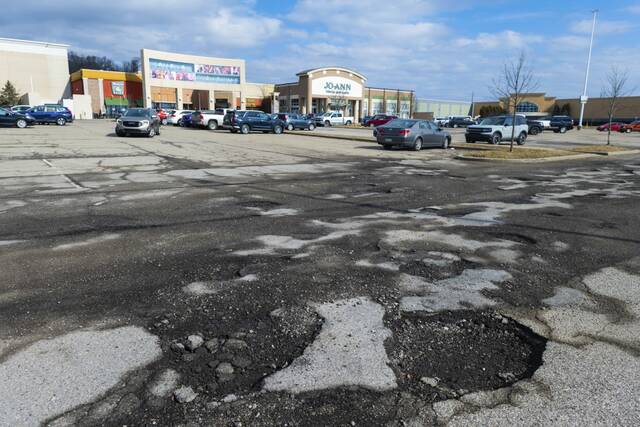Editorial: The dying revenue stream of a neglected mall
A mall is not easy money.
According to the International Council of Shopping Centers, an average mall might be 400,000 to 800,000 square feet — and that’s just the storefronts available for lease. It doesn’t include the common spaces that connect them and often serve as drivers for people to congregate. It also doesn’t include acres of parking outside and the private roads linking to the public.
A mall can cost millions to build and more to operate. It’s a vast amount of real estate to keep functional and safe. Done correctly, however, malls can generate hundreds of dollars per square foot.
To be fair, most malls are not completely rented. Drive around Southwestern Pennsylvania, and you see a lot of empty storefronts in the Pittsburgh Mills or Monroeville Mall — and the demolition site that once was Century III Mall in West Mifflin.
Commercial real estate company Cushman & Wakefield, which maintains offices in Pittsburgh, estimated retail vacancies are down to a 20-year low for the second quarter of 2024. That’s good news for malls.
But, to fill those spaces, the malls have to be worth renting the space. The problem with many malls is the lack of commitment to the property.
A TribLive investigation shows the slow, agonizing death of Pittsburgh Mills is not an isolated case. It’s an epidemic of neglect throughout the malls owned by Namdar Realty Group of New York.
The company, owned by Long Island billionaire Igal Namdar, made $86.7 million in 2023. That was a 10% jump over 2022, per the Wall Street Journal.
It’s a drop in the bucket to what could be made by a thriving, well-run shopping center. If just one average-size mall was fully leased at a mid-range $400 per square foot, the take would be about $160 million.
But, to get that, you have to put in the work to make the mall a place people want to go. You have to make sure the parking lot isn’t a dangerous pile of rubble. There’s marketing, investment and overhead needed to earn the big bucks.
Namdar owns seven malls across Pennsylvania and others elsewhere. The history of those malls is of near-miss loss at sheriff’s sale, lawsuits filed by local government to compel maintenance of dilapidated parking lots and roads and the company suing to lower its tax obligation because the rundown space just isn’t worth what it once was.
All of that was just Pittsburgh Mills. Beaver Valley Mall in Center Township is described as a “ghost town” by a township supervisor. The only option left in the Logan Valley Mall food court in Altoona is Auntie Anne’s Pretzels. In Wyomissing, the Berkshire Mall has a partially collapsed roof over the BonTon anchor store that has been condemned for two years.
The Chambersburg Mall closed in 2023. Developers wanted to place a mini-casino there. Namdar declined to cooperate, and the project moved to Shippensburg.
That’s indicative of a disdain to do what is needed to make the properties — and, by extension, the communities — thrive. The Live Casino Pittsburgh’s presence at Westmoreland Mall has done more than bring in gamblers. It’s done what people hoped would happen, creating new growth in and around the mall.
Namdar, however, continues to be happy with slowly squeezing the last drops of revenue from Pittsburgh Mills. It might be an easier way to make money, but it guarantees the revenue stream won’t last.
Remove the ads from your TribLIVE reading experience but still support the journalists who create the content with TribLIVE Ad-Free.

